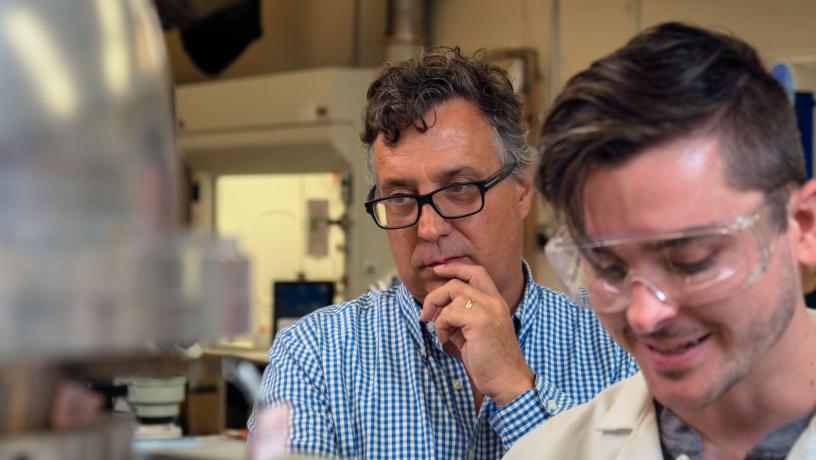Columbia Engineering Launches New Center for Research into Renewable Energy and Energy Storage
Multi-disciplinary engineering team aims for breakthroughs in battery and fuel cell efficiency
Columbia Engineering has launched a new research center, the Columbia Electrochemical Energy Center (CEEC), to address energy storage and conversion using batteries and fuel cells in transformative ways that will ultimately enable the widespread use of renewable energy and the associated need for energy storage. The Center is co-directed by Alan C. West, Samuel Ruben-Peter G. Viele Professor of Electrochemistry, and Daniel Steingart, associate professor of earth and environmental engineering, who will join Columbia Engineering from Princeton University in January 2019.

Interested in Clean Energy?
Dive deeper with the cover story for our Fall 2018 issue of Columbia Engineering Magazine
Introduction to the Columbia Electrochemical Energy Center
The new center takes a whole systems approach, connecting engineers with a wide range of technical expertise and research interests to industry leaders and government policy makers. The center intends to establish a testbed to study how battery systems interact with other efficient technologies, including thermal storage. It will also draw on the decade-long data and on-the-ground experience in rural areas in India and Africa to find solutions that are scalable and economically feasible.
“By establishing a multi-disciplinary center dedicated to batteries and fuel cells, we are making a commitment not only to renewable energy and the associated need for energy storage, but to the larger goal of a more sustainable humanity,” said Mary Boyce, Dean of Columbia Engineering.
West, an expert in electrochemical systems, and Steingart, who is known for finding “out-of-the-box” solutions to complex problems, have assembled a team of professors whose collective expertise encompasses fundamental and applied research into batteries and fuel storage, with experience in applications ranging from electric cars to the power grid.
“That diversity of talent, with research spanning the atomic-scale through materials to large-scale systems, is one of the center’s greatest strengths,” says West. “By bringing together engineers from chemical, electrical, mechanical, materials science, and earth and environmental engineering, the potential for a breakthrough at the intersection of different fields is exponentially multiplied.”
Regulations and mandates to reduce greenhouse gases are driving research into battery storage and fuel cell technology. Unlike fossil-fueled power plants that produce electricity on demand, renewables such as wind, solar, and water require storage solutions on an unprecedented scale because sun and wind are intermittent energy sources. As more people move to urban centers, energy requirements for transportation and buildings are also expected to grow.
The Center’s goals are to push the frontiers of electrochemical science and technologies needed for the widespread adoption of renewable electricity and to advance sustainable production of chemicals and fuels powered by renewable electricity. Ultimately, it will tackle the biggest challenges facing widespread adoption of electric transportation, clean urban buildings, grid-level storage of renewables, and the use of battery systems to provide access to energy to developing countries.

CEEC codirector Alan West
By bringing together engineers from chemical, electrical, mechanical, materials science, and earth and environmental engineering, the potential for a breakthrough at the intersection of different fields is exponentially multiplied.
The Center brings together a diverse team of researchers, who work on the atomic level up to the electrical grid on a wide range of projects to drive the field forward. The team includes:
Alexander Urban, who works on the atomic level to find new materials that will, for example, reduce degradation on electrode surfaces. Electrode degradation is a limiting factor for the lifetime of lithium-ion batteries, and other key technology. He joins the center in January from the University of St. Andrews.
Lauren Marbella, who develops imaging techniques that can lead to better ways to formulate and evaluate energy storage systems. Her techniques shed new insights on how battery materials are degraded by mechanical stress, as well as during normal usage.
Yuan Yang, who studies fundamental processes in battery reactions. His work addresses limitations on capacity, charging speeds, and power levels that are impeding battery adoption for many applications.
Jingguang Chen, an expert in hydrogen chemistry, surfaces, and electrochemical reactions. Chen investigates cheaper and more efficient electrocatalysts that could make widespread use of fuel cells economically viable. He maintains part of his research group at Brookhaven National Laboratory, using its synchrotron and computational facilities.
Dan Esposito, who leads a group designing novel materials and device concepts for synthesizing solar fuels without any CO2 production. His work carries significant implications for various platforms.
Alan West, co-director. West’s group builds mathematical models capable of accounting for thousands of conditions, revealing new strategies for optimizing performance through transforming battery architecture. His current work could drive us closer to electric cars that can be charged in 15 minutes.
Dan Steingart, co-director. An experimentalist, Steingart’s work tackles complex problems from cheaper, longer-lasting devices to stretchable batteries, with an eye toward unconventional solutions.
Matthias Preindl, who focuses on the design and control of power electronic and motor drive systems for power applications, such as electric vehicles. Price point is currently one of the main impediments to widespread adoption of electric vehicles; Preindl uses machine learning and optimization-based estimation and control techniques to create cheaper, more efficient active-balancing hardware that could slash costs.
Vijay Modi, who leads a group that has created usage-based, card-enabled payment systems bringing energy access to those living off the grid in developing countries. These smart controllers are being deployed in many rural settings in India and sub-Saharan Africa, as a way to economically and efficiently facilitate solar-fueled “mini-grids.”
Modi has collected nearly a decade’s worth of data on how solar-powered mini-grids backed by batteries operate in hot, dusty conditions. That data will helping him and CEEC colleagues Yang, Steingart, West, and Preindl refine the controller algorithms for intelligent battery management systems, providing just one example of the synergies that the new Columbia Electrochemical Center is expected to spark.
###
Columbia Engineering
Columbia Engineering, based in New York City, is one of the top engineering schools in the U.S. and one of the oldest in the nation. Also known as The Fu Foundation School of Engineering and Applied Science, the School expands knowledge and advances technology through the pioneering research of its more than 220 faculty, while educating undergraduate and graduate students in a collaborative environment to become leaders informed by a firm foundation in engineering. The School’s faculty are at the center of the University’s cross-disciplinary research, contributing to the Data Science Institute, Earth Institute, Zuckerman Mind Brain Behavior Institute, Precision Medicine Initiative, and the Columbia Nano Initiative. Guided by its strategic vision, “Columbia Engineering for Humanity,” the School aims to translate ideas into innovations that foster a sustainable, healthy, secure, connected, and creative humanity.
